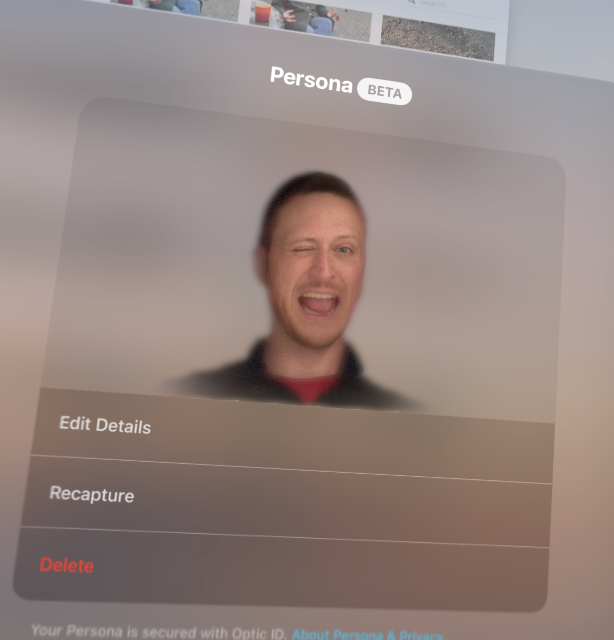The human interface of Vision Pro: Personas and EyeSight

There's something horrible about the uncertainty of if someone can see you or you can see them. Two way eye contact is something we absolutely take for granted. It's a connection that is about more than just paying attention, it's about sharing presence with a real person.
Headsets are slathered in pitfalls around this area. How do I know if someone just came in the room if I have it on? How do they know if I can see them or not? How do you do a videocall with no face? How do you know if someone with Google Glass or Snap shades is recording you?
The Eyes have it.
Personas and EyeSight are Apple's attempt to tackle a challenge where nobody else has had the courage or resources to even try.
If you approach the product from what's necessary and important, rather than just what's easy and possible, it's absolutely a challenge that needs to be tackled. Put another way: if you can solve how you interface with other people, then you remove one of the biggest barriers to using these devices in real life.
Personas, Apple's quick 3D render of your head, have received a lot of flack. They are not perfect. They are crude approximations, kind of squeezing an infinite array of possible faces into a much smaller set of boxes (often in such a way that you look like you have been squeezed into the box.)
But the way mine moves is uncanny to me, in a good way. And it's about the animation and action and nuance and representation of what I'm trying to communicate.
I wonder if it feels better because I know what I'm trying to do when I'm looking at it – so what comes out is expected. Whereas for a viewer in our team Discord channel, it may all feel more random.
One of the things I believe they get really right is that the eyes are the anchor of our experience with people. They are where your attention dwells and where "life" and consciousness comes through somehow.
I think my Persona's eyes do capture the glint of consciousness and I don't think that's something that comes easily. It takes a lot of work to make something like that look easy.
Secondly, my Persona is constantly animated with the microexpressions and wiggles and randomness of a human being. I've tried making the smallest possible movements – eyelids, corners of the mouth – and the only thing I can't get to register is flaring my nostrils.
If you are looking at a Persona critically, I think it's INCREDIBLY easy to say it looks like a poor to middling Playstation model. But if you're trying to communicate with someone, I think this foundation focuses on the most important areas of detail, nuance, expressiveness that make communication work.
EyeSight for sore eyes
Let's move onto EyeSight, the system by which your Persona's eyes show up on the outside of the headset.
It has the same challenges of the Persona at its core – virtual eyes look silly compared to real eyes. But for me, the question is: do they add possibilities or utility that belongs in a product like this?
Yes yes yes yes yes yes yes.
Because I'm in full immersion mode, trying to use this product in as many situations as possible, I was using Vision Pro to work on a cinema-sized screen in my tennis club this week. Another member was queuing for a coffee and clocked the headset, and (reasonably enough!) had a bit of a look to work out what was going on.
I double-clicked the digital crown and said hello with a little wave. And we could have a little chat about Apple's new head computer. I guess he could see my little eyes, which made the experience a bit less horrible.
A bit less horrible is all you need sometimes.
Elsewhere, I've been using it to work at home and sometimes my kids slam into my office to demand fresh snacks or mind-rotting cartoons. For them, they don't know at all what's normal and what's not normal in tech – but because they can see my eyes, they know I can hear them and know I'm paying attention. That's enough to make it work.
Is it great? No, it's not great. But it's a first attempt where nobody else has bothered and, in real world usage, it is enough to convince me that something like this makes a big difference in this kind of product and its their bloody job to try and solve it. So I hugely encourage their efforts here.
Wrapping up, there's another feature of the product that makes it easy to communicate with people that you might not expect: The headstrap.
There are ways in which the double loop (which includes a second strap over the top of your head to hold some of the weight) is better, and ways in which it's worse (itchy.)
But the great virtue of the single loop strap for me is it's so easy to just whip this thing off, or chuck it on again if you need to. It's in "thoughtless" territory, like opening or closing a laptop.
That matters because ultimately the best way to communicate wearing a headset, is to take off the headset.
Between these three areas, I'm deeply encouraged by a product team that's actually trying to tackle the real world challenges of making this kind of tech useful – rather than insisting none of it will matter because "metaverse".

